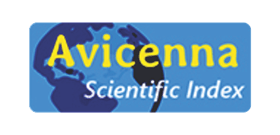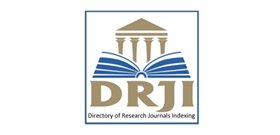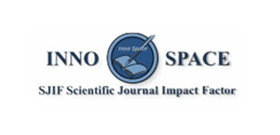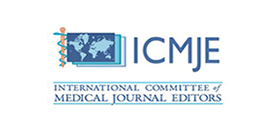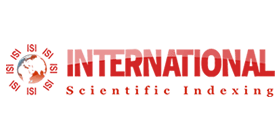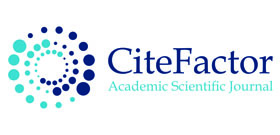Table of Content
Era's Journal of Medical Research: Volume-11 Number-2, 2024
ASSESSMENT OF NON-INVASIVE TESTS IN HBEAG-NEGATIVE CHRONIC HEPATITIS B
Meral Sozen Department of Gastroenterology Dr. Meral Sözen Clinic, Ufuk Üniversitesi Straat, The Paragon Tower Çukurambar No:17-3 Çankaya, Türkiye-06530 Download PDF
Download PDF
 View in XML
View in XML
 View in DOI
View in DOI
MORTALITY OUTCOMES ASSOCIATED WITH INVASIVE ASPERGILLOSIS
Raksha, Gurjeet Singh Department of Microbiology Abhishek I Mishra Memorial Medical College and Research, Junwani Road, Bhilai, Durg, Chhattisgarh – 490020 Download PDF
Download PDF
 View in XML
View in XML
 View in DOI
View in DOI
ROLE OF HRCT IN EVALUATION OF PATHOLOGIES OF TEMPORAL BONE AND ITS SURGICAL INTERVENTION
Sarfraz Ahmed, Ganesh Kumar, Yayati Pimpalwar, Sadaf Sultana, Mufidur Rehman, Kanika Malhotra Department of Radiodiagnosis Integral Institute of Medical Sciences and Research, Lucknow, U.P., India-226026. Download PDF
Download PDF
 View in XML
View in XML
 View in DOI
View in DOI
PANCREATO PROTECTIVE AND ANTI-INFLAMMATORY EFFECTS OF PTEROCORPUS MARSUPIUM ON RAT PANCREATIC ISLETS IN STREPTOZOTOCIN-NICOTINAMIDE INDUCED DIABETES MODEL
Bheemesh Vangalapati1, Poornima Ajay Manjrekar2, Anupama Hegde3, Jyothi Ramnath Kini4, Anuradhalaxmi Kemminje5 Department of Pharmacology1, Department of Biochemistry2,3,5, Department of Pathology4 American University of Barbados School of Medicine, Barbados-BB111001. Kasturba Medical College, Mangaluru, Manipal Academy of Higher Education, Karnataka, India-5750012,3,4. Kanachur Institute of Medical Sciences, Mangaluru, Karnataka, India-5750225. Download PDF
Download PDF
 View in XML
View in XML
 View in DOI
View in DOI
SPECTRUM OF THYROID LESIONS ON FNAC IN A TERTIARY CARE CENTRE OF NORTHERN INDIA
Mohd Mueen Khan1, Syed Fiza Mustaqueem1, Priyanka Singh1, Shiva Tiwari2 Department of Pathology1, Consultant Endocrinology2 Integral Institute of Medical Sciences and Research, Integral University, Lucknow, Uttar Pradesh, India-2260261 SP&SS Medical Research Support Services LLP, Lucknow, India - 2260122 Download PDF
Download PDF
 View in XML
View in XML
 View in DOI
View in DOI
EVALUATION OF CAROTID ARTERIAL SYSTEM IN STROKE PATIENTS USING COLOUR DOPPLER SONOGRAPHY IN A TERTIARY CARE INSTITUTE
Kanika Malhotra, Lavan Saxena, Ganesh Kumar, Abhishek Agrawal, Zeeshan Siddiqui Departent of Radiodiagnosis Integral Iinstitute of Medical Sciences and Research, Lucknow, U.P., India - 226026 Download PDF
Download PDF
 View in XML
View in XML
 View in DOI
View in DOI
CYTOMORPHOLOGICAL SPECTRUM OF PALPABLE THYROID LESIONS AND THEIR CORRELATION WITH SONOGRAPHIC FINDINGS
Shweta Singh Yadav, Nausheen S Khan, Priyanka Singh Department of Pathology Integral Institute of Medical Sciences and Research, Integral University, Lucknow, Uttar Pradesh, India-226026 Download PDF
Download PDF
 View in XML
View in XML
 View in DOI
View in DOI
ASSOCIATION OF SERUM ELECTROLYTE CHANGES WITH ACUTE CORONARY SYNDROME: A NARRATIVE REVIEW
Shubham Saini1, Jyoti Dwivedi2, S. Mohd. Shiraz Rizvi2 Department of Biochemistry SCPM College of Nursing and Paramedical Sciences, Gond, U.P. India - 2710031 Era's Lucknow Medical College and Hospital, Era University, Lucknow, U.P. India - 2260032 Download PDF
Download PDF
 View in XML
View in XML
 View in DOI
View in DOI
BLENDED LEARNING IN DENTAL SCIENCE EDUCATION: A REVIEW
Kafilul Bari Khan Department of Conservative Dentistry and Endodontics Kalinga Institute of Dental Sciences, KIIT University (Deemed to be University), Bhubaneswar, Odisha, India - 751024 Download PDF
Download PDF
 View in XML
View in XML
 View in DOI
View in DOI
ROLE OF IMMUNOGENICITY IN DRUG DEVELOPMENT
Afra Habib1, Subuhi Anwar2, Bishouno Bhowmick3 Department of Biochemistry1, Department of Pathology2, Department of Pharmacology & GP3 King George’s Medical University, Lucknow, U.P., India-2260031 Era’s Lucknow Medical College and Hospital, Era University, Sarfarazganj, Lucknow, U.P., India-2260032. American University of Barbados School of Medicine, Barbados-BB111003. Download PDF
Download PDF
 View in XML
View in XML
 View in DOI
View in DOI
FERROPTOSIS AND THEIR EMERGING ROLE IN DISEASE PROGRESSION AND TREATMENT
Syed Ibrahim Rizvi, Raushan Kumar Department of Biochemistry University of Allahabad, Prayagraj, Uttar Pradesh, India - 211002 Download PDF
Download PDF
 View in XML
View in XML
 View in DOI
View in DOI
GUT MICROBIOTA IMPACT ON HUMAN HEALTH AND DISEASES
Prakshalya Mishra1, Babita Tiwari2, Ghizal Fatima2 Department of Research Metabolic Unit1, Department of Biotechnology2 Era University, Sarfarazganj, Lucknow, U.P., India-226003. Download PDF
Download PDF
 View in XML
View in XML
 View in DOI
View in DOI
BONE BUILDING HORMONES: A REVIEW
Dr. Arpit Agarwal Lab Director, Clinical Pathology Lab (CPL) Agra, UP, India Download PDF
Download PDF
 View in XML
View in XML
 View in DOI
View in DOI
SYSTEMATIC REVIEW ON RELATIONSHIP OF NEUROLOGICAL TUMORS WITH ABO BLOOD
Km Shivani, Seema Singh, Syed Tahseen Raza, Abdussalam, Javeria Fatima, Sudhanshu Shekhar Department of Physiology Era’s Lucknow Medical College and Hospital, Era University, Sarfarazganj, Lucknow, U.P., India-226003. Download PDF
Download PDF
 View in XML
View in XML
 View in DOI
View in DOI
ADENOSINE IN CARDIOVASCULAR PHYSIOLOGY: MULTIFACETED ROLES IN CORONARY VASODILATION, ATHEROPROTECTION, AND PLATELET REGULATION
Mostafa Waly1, Sanchita Srivastava2, Riya Nag3, Kaynat Fatima2, Ale Eba2 Department of Food Science & Nutrition1, Department of Biotechnology2, Department of Biochemistry3 CAMS, Sultan Qaboos University, Muscat, Oman1 Era’s Lucknow Medical College and Hospital, Era University, Sarfarazganj, Lucknow, U.P., India-226003. Download PDF
Download PDF
 View in XML
View in XML
 View in DOI
View in DOI
MYTHS AND FACTS OF STABLE ANGINA
Subuhi Anwar1, Reeta Chaudhary2 Department of Pathology Era’s Lucknow Medical College and Hospital, Era University, Sarfarazganj, Lucknow, U.P., India-2260031. Advanced Center for Treatment Research and Education in Cancer (ACTREC), Tata Memorial Centre, Khargar, Navi Mumbai, India-4102102. Download PDF
Download PDF
 View in XML
View in XML
 View in DOI
View in DOI
CONCEPT AND REQUIREMENTS OF ESTABLISHING GREEN LABORATORIES: SCOPING REVIEW
Mehnaz Khan1, Shreya Bhattacharya2, Sudarshana Gogoi1, Sharique Ahmad1 Department of Pathology1,2 Download PDF
Download PDF
 View in XML
View in XML
 View in DOI
View in DOI
ARTIFICIAL INTELLIGENCE IN PATHOLOGY: PRESENT AND FUTURE
Saqib Ahmed Department of Pathology Shri Guru Ram Rai Institute Of Medical & Health Sciences, Dehradun, Uttarakhand, India-248001. Download PDF
Download PDF
 View in XML
View in XML
 View in DOI
View in DOI
STUDY OF PERCEPTION OF SENSITIVITY TOWARDS PATIENTS' CONDITION AMONG ALLIED HEALTH CARE UNDERGRADUATE STUDENTS USING PHOTOGRAPHY
Rupali Mirza, Madhu Pandey Department of English, Department of Psychology Era University, Lucknow, Uttar Pradesh, India-226003 Amity Institute of Behavioural and Allied Sciences, Amity University, Lucknow, Uttar Pradesh, India-226010 Download PDF
Download PDF
 View in XML
View in XML
 View in DOI
View in DOI
THE GENETICS OF CYP GENE VARIANTS IN ASSOCIATION WITH POLYCYSTIC OVARY SYNDROME: A NARRATIVE REVIEW
Jyoti Dwivedi, Aparna Misra, Ayesha Ahmad Department of Biochemistry, Department of Obstetrics and Gynaecology Era’s Lucknow Medical College and Hospital, Era University, Sarfarazganj, Lucknow, U.P., India-226003. Download PDF
Download PDF
 View in XML
View in XML
 View in DOI
View in DOI
TAURINE'S CRUCIAL FUNCTION IN METABOLIC DISEASES
Indrajeet Singh1, Pooja Kushwaha2 Department of Biotechnology1, Department of Biochemistry2 Faculty of Engineering and Technology, Rama University, Kanpur, U.P., India-2092171 University of Lucknow, Lucknow, U.P., India - 2260072. Download PDF
Download PDF
 View in XML
View in XML
 View in DOI
View in DOI
NATURAL AGENTS IN THE MODULATION OF METABOLIC SYNDROME
Fauzia Bano, Seema Kanojia, Arvind K. Srivastava Department of Food and Nutrition Era University, Sarfarazganj, Hardoi Road, Lucknow, U.P., India-226003. Download PDF
Download PDF
 View in XML
View in XML
 View in DOI
View in DOI
UTERINE LIPOLEIOMYOMA : A RARE CASE REPORT
Renu Sahay, Madhu Singh Department of Pathology MLB Medical College, Jhansi, U.P., India-284001. Download PDF
Download PDF
 View in XML
View in XML
 View in DOI
View in DOI
A CASE OF MIXED INFILTRATING (LOBULAR AND DUCTAL) BREAST CARCINOMA IN A PREVIOUSLY DIAGNOSED PATIENT OF UDH
Geetika Kapoor, Nishi Tandon, Andleeb Zehra, Nirupma Lal Department of Pathology Era’s Lucknow Medical College and Hospital, Era University, Sarfarazganj, Lucknow, U.P., India-226003. Download PDF
Download PDF
 View in XML
View in XML
 View in DOI
View in DOI
SURGICAL APPROACH TO A LARGE DENTIGEROUS CYST AND ASSOCIATED IMPACTED TEETH:INSIGHTS FROM A CLINICAL CASE
Vidya M S , Sachin Aslam A, Mathew PC, Tom Thomas, Anu Jose Department of Oral and Maxillofacial Surgery MES Dental College and Hospital, Perinthalmanna, Kerala, India - 679321 Download PDF
Download PDF
 View in XML
View in XML
 View in DOI
View in DOI
CASE REPORT: COLORECTAL CARCINOMA IN A YOUNG ADULT MALE
Farheen Khan, Nishi Tandon, Noorin Zaidi, Sumaiya Irfan, Andleeb Zehra, Nirupma Lal Department of Pathology Era’s Lucknow Medical College and Hospital, Era University, Sarfarazganj, Lucknow, U.P., India-226003. Download PDF
Download PDF
 View in XML
View in XML
 View in DOI
View in DOI
TUMOUR RECURRENCE OF METAPLASTIC SPINDLE CELL CARCINOMA BREAST
Rashi Vaish, Nishi Tandon, Andleeb Zehra, Akanksha Sharma, Mohd Ibrahim, Nirupma Lal Department of Pathology Era's Lucknow Medical College and Hospital, Era University, Sarfarazganj, Hardoi Road, Lucknow, U.P. India-226003 Download PDF
Download PDF
 View in XML
View in XML
 View in DOI
View in DOI
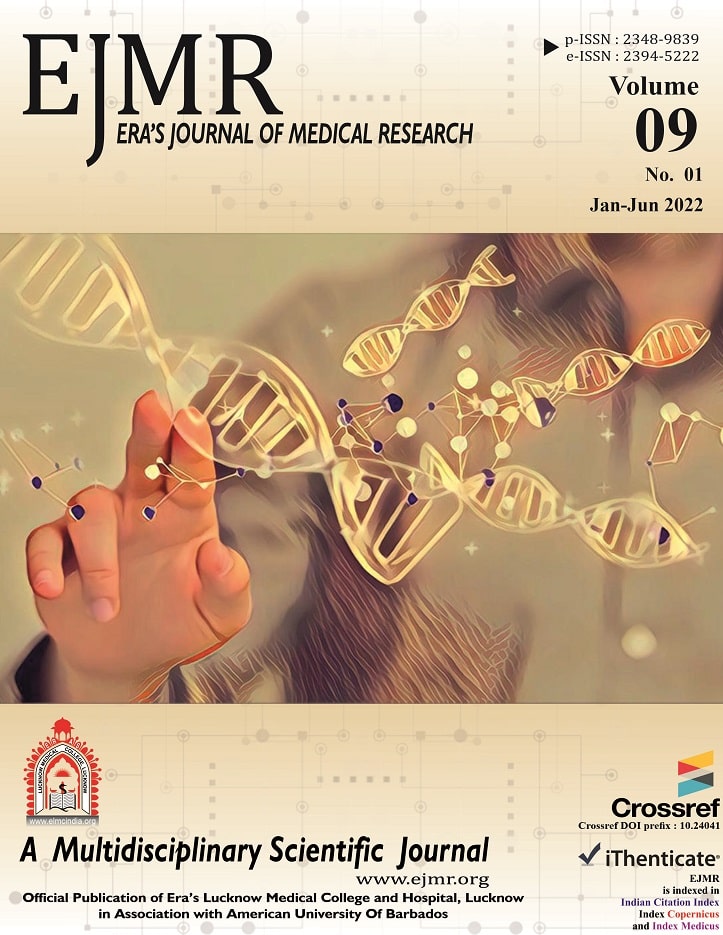
From the Editor’s Desk
CANCER–INITIATION & CANCER STEM CELLS
The effort to understand as to why cancer re-emerges despite treatment by chemotherapy or radiotherapy along with full surgery has revealed many new facts and theories responsible for this, the most important of all these has been the concept of cancer stem cells which lie dormant, silently & secretly, during all this period. Watching and investigating closely has revealed this not to be a straight, easy and simple task. Many processes, pathways and chemical/enzymes/hormones are involved to baffle the mind. Progression and reprogression / metastasis of cancer to other organs has lead to relevation of many new facts.
In order to simplify this difficult process, the easiest and first thing to focus is on one single aspect of this whole complicated story. We start this narrative with cancer stem cells and their microenvironment.
Our observations and derived concepts, tell us that cancer stem cells are similar to normal stem cells or progenitor cells which also have the ability for self renewal and differentiation in multiple directions to cause tumor mass production. This first step called tumor initiation occurs because of large number of mutations occurring in the DNA of the cell. Most of the times, this is helped with epigenitics and assisted by microenvironment. Microenvironment comprise many supportive factors, enzymes/hormones etc, along with inflammatory and immune cells.
Once so many mutations have taken place within the cell, the cell loses its control over cell division and acquires other malignant properties.
This conversion of a quiescent stem cell into cancer stem cell and then into active cell can take place even in non-cancer stem cell. There are many controversial views about this fact and the origin of cell is doubtful.
Nevertheless, this process of mutation continues and converts such a cell into more aggressive phenotype. This phenotype proliferates and tumor results.
The interaction of this cancer cell, the effects of chemotherapy or therapeutic intervention produce fully developed/ often resistant cancer cells.
More over, role of stemness transcription factor SOX-2 has been studied in detail. SOX-2 positively expressing cells when transplanted to mice, give rise to tumor formation. Whereas if transcription factor is deleted even from established tumors, the regression of tumor takes place.
The other important factor causing initiation of cancer is inflammation. Some of the viruses have been associated with this; viruses like HPV, hepatitis B & C, etc and helicobactor pylori. This is medicated through reactive oxygen species (ROS) reactive nitrogen species (RNS) and lipid poroxidation products (LPP). These toxic by products cause mutation in gene and through this process, initiate cancer.
Inflammation not only causes initiation of cancer under favorable conditions but it even persists through all phases of cancer development. The stem cells, the stem cells niche and the ROS, RNS and LPP all are related in cause and effect manner. The detailed mechanisms are still not clear.
The CSC niche also promotes and safeguards the progression and maintenance of stem cells in the long run via self renewal and angiogenesis. In turn, CSCs also modulate microenvironment for their survival, growth and metastasis.
The next phase in cancer development and the role of cancer stem cells comes through neoangiogenesis. As the cancer has been established, it grows and with its growth the size increase requires more food hence more circulation. This is met through neoangiogenesis. This need is fulfilled through microenvironment which produces, newer micro blood vessels. This in turn is helped by cancer stem cells; marked by surface markers CD31/ CD34, etc and endothelial cells.
These and other factors co-ordinate to secrete proangiogenic factors. The actual process involves great or details found in literature. During tumor developmental process and stem cells coordination comes the role of drug resistance.
Prof. A. N. Srivastava
Director Research
Era’s Lucknow Medical College & Hospital Lucknow







